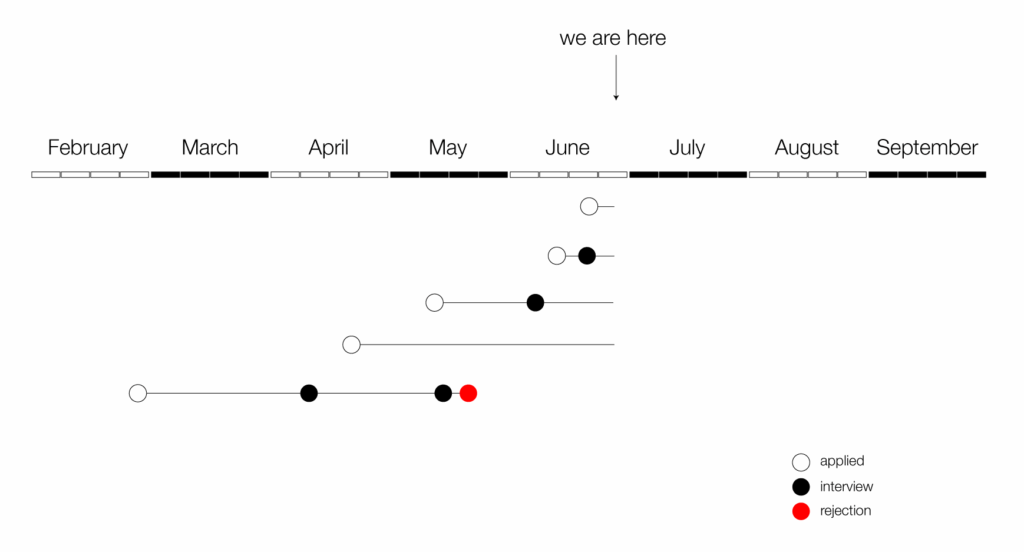I started my design career by hiring people back in 2007 so as an experienced hiring manager, here are some observations based on the last four months of my own job search (and supporting others in theirs).
- Nobody knows how to write a CV anymore. Almost all of the graduates I’ve spoken to think a CV is an academic poster and try to cram too much in. I think they’re following some weird one page templates kicking around the internet. If I saw any of those as a hiring manager I would immediately move on. I dread to think how universal this is and I wish we’d just use Linkedin profiles instead. At least it lets people know what they might want to include and our familiarity with the format means we’re less likely to fault people for misunderstanding how to lay things out for print/offline reading. I’m not advocating for an ‘Easy Apply’ approach to CVs, I just think we need to revisit the basics of what makes a good CV and say that to young people before they graduate. They are digital natives and a CV is an 19th century habit that dies hard. We have to help them, not punish them.
- Nobody knows how long a job description should be. I wrote about this back in March and it’s really bad out there. I’ve broadly given up on reading job descriptions word by word. Instead I look at the shape of a job description. I look at whether I think it’s been written with ChatGPT or not. I look at whether it’s one person’s job or several rolled into one and I try to guess whether that’s a red flag or not. I try to speak to someone in the organisation to get some context behind the hire. I almost never just take the job description at face value.
- Don’t advertise if you’re going to promote internally. If you do, say so. This grinds my gears the most and I’m only guilty of doing this once in my entire career thankfully. A few years back, after 3 interviews, I was told people were concerned about me being a good ‘culture fit’ as a reason for not offering me the role. I was devastated as I worried about how I’d come across. I later found out they had just promoted someone internally. I would have appreciated just hearing ‘we’ve made the decision to promote someone into the role’ instead of what felt like a mini character assassination.
- Sifting is not hard but it takes time. The people who really ‘get’ hiring are in academia and in venture capital. They have hundreds and hundreds of applicants every year for their degrees or incubators so they set aside the time to sift. This is not hard, it’s just about prioritising the activity. In creative environments where meetings are 30 minutes and there is a stream of semi-continuous interruptions on Slack, taking 3 days to sift may look like a bad use of time but it’s not the case. Choosing who you will take time to speak to is really important because that person will have an immediate effect on your team no matter the size of the business. If you value your colleagues, you’ll take that time so that you can make the best possible decision. And stop hiding behind ‘we won’t be able to let you know if you’ve not been selected’ because any good ATS system will let you do that well and quickly. If you don’t have one, buy one, because investing in getting the applicant experience right protects your reputation.
- Be aware of your ‘time to interview’. In my last roles, I made sure you’d know whether you’d been selected for an interview within a week of the deadline. I think that’s a pretty good principle. As you can see from the diagram above, I’m still waiting to hear back from some folks months after I applied. This is quite dangerous from an equity perspective. What happens when you let months go past is that you’re assuming someone can afford to wait around for you to make a decision. Not everyone can.
- Brief your colleagues. I’ve shown up to second or third interviews where people clearly hadn’t looked at my CV, had not read my cover letter and weren’t properly briefed by the colleagues that had conducted the first interviews. This is a risk if you have a multi-step hiring process because there’s no ‘laddering up’ of decision-making. And it feels terrible as an applicant because you don’t know whether you should re-explain everything all over again or not. An intro that starts with ‘we’ve read the notes from our colleagues’ would go a long way but I’ve never had that.
I think hiring is an art and a unique human experience. Get it right and people can move on quickly and retain respect for you as an organisation. Get it wrong and you’re impacting your reputation just a little. You never know where someone you said ‘no’ to will end up and gods know people talk. So why take the risk?
If you’d like some eyes on your hiring process, I’m available as a contractor or you can book some time with me for a free CV review.
Discover more from designswarm {thoughts}
Subscribe to get the latest posts sent to your email.

